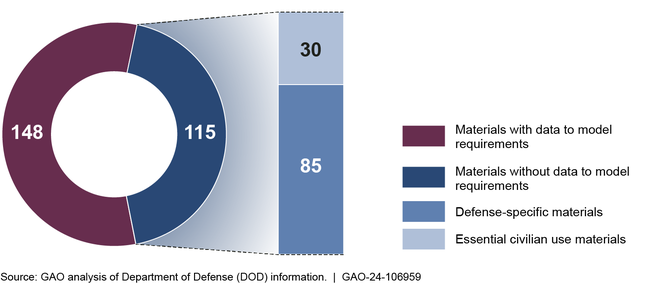National Defense Stockpile: Actions Needed to Improve DOD's Efforts to Prepare for Emergencies
Fast Facts
World conflicts and other emergencies can disrupt supply chains for materials that the military and U.S. industries depend on—such as titanium, a strong, lightweight metal that helps prevent corrosion in weapon systems. To prepare for such emergencies, DOD maintains a stockpile of these kinds of materials.
DOD has processes to manage this stockpile and identify which critical materials to include. But DOD doesn't have the information necessary to estimate all of its critical material needs, or clear guidelines for when to release materials from the stockpile for use.
We recommended that DOD address these issues and others we found.
Raw titanium that can be used to produce weapon systems

Highlights
What GAO Found
The Department of Defense (DOD) maintains the National Defense Stockpile to store materials that are strategic and critical to defense and essential civilian needs in times of national emergency. DOD has processes for identifying material requirements and managing the stockpile, but some aspects are not fully defined. For example, DOD does not require relevant entities, such as program offices, to provide the necessary data to model requirements for over 40 percent of its strategic and critical materials. Without data to model more requirements, DOD risks not having stock of its highest priority materials.
Data Available to Model DOD's Strategic and Critical Material Requirements, Fiscal Year 2023

DOD's biennial stockpile reports to Congress included details on stockpile inventory and material shortfalls, but did not include information on all risks and prior actions taken to address them. DOD's reports indicate that from fiscal years 2019 to 2023, DOD primarily stockpiled the same 50 types of materials, but the number of materials in shortfall increased by 167 percent, from 37 to 99. The reports included some information about risks, such as the type of products affected, and recommended actions to address the shortfall. However, in the fiscal year 2023 report, DOD either did not have or chose not to include all information needed for congressional and DOD decision-making, such as
- a list of all materials in shortfall, rather than just those deemed priorities,
- the risk associated with materials it could not model, such as affected weapon systems, or
- the status of DOD efforts to implement recommendations from its prior reports.
Over 90 percent of the materials DOD identified in shortfall in fiscal year 2023 had either zero or one domestic supplier. In addition to stockpiling, DOD is mitigating some of the risks of relying on foreign or a single domestic source of supply by recycling materials from no-longer-used equipment, qualifying new domestic sources, and funding research and development projects to identify new ways to process critical materials. Even with these efforts, DOD estimates it will need $18.5 billion to address all shortfalls identified in fiscal year 2023.
Why GAO Did This Study
The Strategic and Critical Materials Stock Piling Act established the National Defense Stockpile to hold materials essential to defense and civilian needs. One such material is titanium, which is a strong, light-weight metal that helps prevent corrosion in weapon systems.
A House report includes a provision for GAO to assess DOD efforts to stockpile strategic and critical materials. This report examines the extent to which DOD (1) established processes for identifying requirements and managing the stockpile, (2) reported to Congress on changes and risks to the stockpile, and (3) is reliant on foreign and single domestic sources of supply.
GAO analyzed DOD's process for developing stockpile requirements, its three most recent biennial stockpile reports (fiscal years 2019 through 2023), and other related documents. GAO also interviewed officials from several entities such as the Defense Logistics Agency, as well as the Institute for Defense Analyses.
Recommendations
GAO is making six recommendations, including that DOD identify: roles and responsibilities for providing data needed to model DOD's requirements for all critical materials and report all shortfalls, the risks associated with unmodeled materials, and the status of previous stockpiling recommendations.
DOD concurred with all six of these recommendations.
Recommendations for Executive Action
| Agency Affected | Recommendation | Status |
|---|---|---|
| Department of Defense | The Secretary of Defense should ensure the Under Secretary of Defense for Acquisition and Sustainment identifies roles and defines responsibilities for relevant DOD entities to provide the necessary supply and demand information on the materials they consider strategic or critical to support DOD's biennial stockpile requirement reports. (Recommendation 1) |
DOD concurred with this recommendation and in response DOD officials said they are reaching out to relevant stakeholders and developing a process to formally communicate the necessary data on strategic and critical materials to the Defense Logistics Agency in support of the biennial stockpile requirements report. As of April 2025, these efforts are still ongoing.
|
| Department of Defense | The Secretary of Defense should ensure the Defense Logistics Agency documents the process for determining actions to address a material shortfall, such as in guidance or job aids. (Recommendation 2) |
DOD agreed with this recommendation and in January 2025 issued guidance for determining what materials to prioritize acquiring for the National Defense Stockpile. This guidance includes a range of recommended actions to address a material shortfall, such as stockpiling the material or conducting additional studies, and when each may be appropriate.
|
| Department of Defense | The Secretary of Defense should ensure the Under Secretary of Defense for Acquisition and Sustainment finalizes criteria to release stockpiled materials for use under Executive Order 14051. (Recommendation 3) |
DOD concurred with this recommendation and in response DOD officials said they are developing comprehensive criteria as well as a standard operating procedure for releasing materials from the stockpile to be more agile in responding to supply disruptions. As of April 2025, these efforts are still ongoing.
|
| Department of Defense | The Secretary of Defense should ensure the Defense Logistics Agency reports the complete list of material shortfalls to Congress while continuing to highlight priority materials. (Recommendation 4) |
DOD concurred with this recommendation and in response DOD officials said they will include the complete list of shortfalls in its 2025 biennial stockpile requirements report. DOD expects the report to be published in July 2025.
|
| Department of Defense | The Secretary of Defense should ensure the Defense Logistics Agency reports information on the risks of unmodeled critical materials to Congress. (Recommendation 5) |
DOD concurred with this recommendation and in response DOD officials said they will include additional information on the risks of unmodeled critical materials in the 2025 biennial stockpile requirements report. DOD expects this report to be published in July 2025.
|
| Department of Defense | The Secretary of Defense should ensure the Defense Logistics Agency reports progress on prior recommendations made to address material shortfalls to Congress. (Recommendation 6) |
DOD concurred with this recommendation. In its response, DOD explained that it provides various information, including progress towards prior recommendations in its National Defense Stockpile Annual Operations and Planning Report. We maintain that the information included in this annual report does not provide visibility into the status of all of the recommendations made to address material shortfalls.
|
